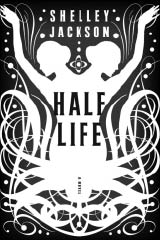Half Life by Shelley Jackson
by Christina Milletti

Shelley Jackson has been playing doctor for a long time—Dr. Frankenstein, that is. In her first fiction, the celebrated hypertext Patchwork Girl, Jackson showcases a female body surgically quilted together. Later, in her collection The Melancholy of Anatomy, she exposes the body’s most private parts in stories called “Blood” and “Phlegm,” as well as “Sperm” and “Egg.” More recently, for her project “Skin,” she tattooed a story one word at a time on 2,095 volunteers. Only these “words”—as she calls her participants (several of whom call Buffalo home)—have ever read the full text of the fiction itself. But her readers know where Jackson’s heart lies: in ogling bodies, their various humors, in order to explore the secrets they hold. Indeed, words, like bodies, she warns, are always in a state of becoming, and even more, bodies and words come into being together. If every “body” tells a story, then, she is the surgeon on duty—always prepared for a bit of exploratory fiction with a scalpel like wit. As she remarks in one interview, “I take a good look at some of the stuff the body sheds or oozes: hair, milk, blood. That unnerving stain on the carpet was once part of your body. Now it’s something you should probably clean up. What happened in between?”
Shelley Jackson’s first novel, Half Life, explores this terrain with a raucous, intelligent tenacity. Nora and Blanche Olney are conjoined twins (a “twofer” in the darkly humorous lingo of the novel): a two-headed woman sharing a single body. But the plot thickens: Nora wants out. The novel then traces Nora’s search for the secretive Unity Foundation, where she’s heard she can get a procedure—euphemistically called “the Divorce”—that will enable her to finally claim to what she feels is her birthright: the “I” she’s never had. As a result, Half-Life is as much a page turner—can Nora really cut off Blanche’s head?—as a meditation on the nature of identity: how does a twofer insert “theirselves” into a singleton “world” as much as singletons “words” when they’re always seeing double? What ensues in Half Life is a labyrinth of plot twists embedded with the history of twofer culture (complete with warring ideological niches such as the “Togetherists” and the “Siamystics”), tied together by Jackson’s darkly humorous language play that mines the possibilities of campy twin culture (in which Twinings tea and Twinkies, for instance, are often preferred snacks). Nora tries to make it all make sense for us because she’s trying to make it make sense to herself. And herein lies the real conflict of the book: in a world of mirror images, how can you tell what is real from what is fiction? Can you really see any clearer with just one set of eyes? Jackson’s conclusions are nothing short of astonishing.
Shelley Jackson reads from her new novel on Friday, March 30, 7pm, at Hallwalls (341 Delaware Avenue) in the Exhibit X Fiction Series. Free.
|
Issue Navigation> Issue Index > v6n13: The Trials of Ralph Hernandez (3/29/07) > Half Life by Shelley Jackson This Week's Issue • Artvoice Daily • Artvoice TV • Events Calendar • Classifieds |









 Current Issue
Current Issue